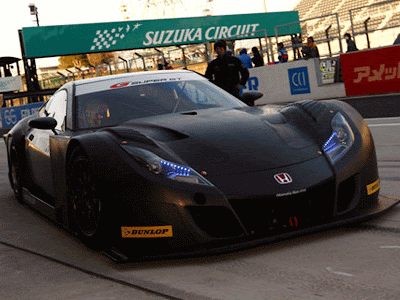BROOKLYN, Mich. (August 21, 2006) – Tomorrow came today at Michigan International Speedway.
In preparation for its 16-race 2007 debut and the gradual, three-year inception of its Car of Tomorrow, NASCAR stayed at MIS for a day after the GFS Marketplace 400 weekend to test the cutting-edge vehicle on the two-mile oval. The Car of Tomorrow is being designed by NASCAR in order to increase safety and reduce costs while maintaining the circuit’s high level of competition.
14 current NEXTEL Cup drivers, including GFS Marketplace 400 winner Matt Kenseth of Roush Racing and teammates Carl Edwards and Jamie McMurray, and four-time NEXTEL Cup champion Jeff Gordon of Hendrick Motorsports, were on hand at MIS to test the vehicles for their respective teams and manufacturers. The first scheduled race for the Car of Tomorrow is at Bristol next spring.
The testing event also marked the on-track testing debut for Toyota’s NEXTEL Cup program, set to roll off at the beginning of the 2007 season. Present for Toyota were Michael Waltrip of Michael Waltrip Racing, Dave Blaney of Bill Davis Racing, and 1988 series champion and seven-time MIS winner Bill Elliott, testing for Team Red Bull. As the clock struck noon and cars were allowed to take the track, Elliott drove the Camry painted with the letters TRB (for Team Red Bull) around the oval to mark the foreign manufacturer’s first stock car foray onto a NASCAR track.
“I’m just proud to be a part of it,” said Waltrip of Toyota’s inauguration. “I know what we’ve done to get here, and that feels good.”
“They’re a new team, and they’ve got a lot of work ahead of them,” said Dodge driver Kurt Busch. “They’re going to change the game of our sport. They’re going to bring in extra money from the manufacturer, and they might step up the level of competition from the auto manufacturers’ side.”
In addition to the new Toyotas, all of the COT prototypes feature many safety enhancements. Among them is a larger driver compartment, which allows competitors easier entry into and exit from their vehicles. The enlarged cockpit will also be more centralized within the car, which will better protect drivers from driver-side impact.
Waltrip, at 6’5” one of the tallest drivers in NASCAR history, couldn’t be happier.
“I was driving down the back straightaway, lookin’ around, and saying, ‘Damn, look at all this room I got!’ That’s just a wonderful feeling, knowing that you’re not all crunched down in there,” Waltrip said. “I’m real sensitive to the space that we have because of my size and it’s just really neat to have that feeling.”
Not everyone is convinced about the increased safety, however.
“Well, I don’t see that there’s that much more room other than headroom,” said Gordon after a test run for Hendrick. “I still have my reservations and concerns. My seat’s moved further inside the car to the right, but I’m closer to the door bars than I was before. To me, there’s not really any big gain there. For me, headroom’s not an issue in the current car we have so that was never an issue that we focused on, but I’m happy that it’s going to work out for those (larger) guys.”
The newly-designed vehicles will feature a more upright windshield and a boxier, thicker front bumper. Both changes will increase drag and reduce speed, thus placing more of an emphasis on driver performance.
No longer will on-track debris create overheating problems. The front air intake of the new vehicles will be obscured by the front bumper.
Adjustable aerodynamic components, like a rear wing and a front splitter, will be available for teams to modify setups in attempts to create advantages.
“It makes it real stable in the back,” said Busch, who tested a car for Penske Racing South as teammate Ryan Newman looked on from the garage in casual clothing before entering the car during the late session. “It makes it tighter to get the car to turn. You’ve got to get that front-end splitter on the ground and free it up somewhere else.”
Unfortunately, just making changes to the vehicles doesn’t necessarily make them competition-ready.
Each team and manufacturer still needs to assess the cars’ performances in heavy traffic. Though the Car of Tomorrow program has tested at Daytona, Charlotte, and Bristol, among a wide array of other tracks, even the drivers themselves know that the Car of Tomorrow is not totally ready to take the green flag.
“By itself, the car drives pretty good,” said Gordon. “My whole thoughts and concerns have always been what it’s going to do in a pack of cars and that’s, you know, what we’re going to find out here, a little bit later on.”
Data from the test will be primarily used in the submission of nose designs for the Car of Tomorrow, which are due to NASCAR on August 28, just a week away.
Though MIS is not on the Car of Tomorrow’s initial schedule of use in 2007, the speedway’s two NEXTEL Cup races in 2008 will feature the progressive machine. After being entered in 26 events in 2008, the Car of Tomorrow will be used in each of the 36 races on the 2009 NEXTEL Cup schedule.
Chip Ganassi Racing with Felix Sabates (David Stremme), Evernham Motorsports (Scott Riggs), Joe Gibbs Racing (J.J. Yeley and Denny Hamlin), MB2 Motorsports (Joe Nemechek), and Haas CNC Racing (Jeff Green) were all represented at MIS as well.
From Michigan Int'l Speedway











No comments:
Post a Comment